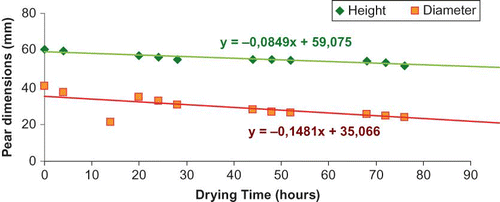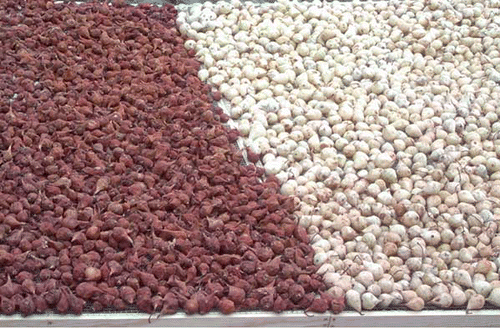Abstract
In Portugal, pears are traditionally dried by a direct sun exposure method, which has many disadvantages. Therefore, alternative dryings are being tested. The objectives of this study were to evaluate how drying influences some properties of pears: moisture, dimensions, water activity, pH, °Brix, acidity, and color. In particular, color is a very important quality attribute of these dried pears. Thus, the different systems should produce products with the same color as the traditional method. The results indicated that the alternative drying methods, if they include sun exposure, allowed us to obtain products similar to the traditional ones.
INTRODUCTION
Drying fruits allows their preservation by reducing the water content and, thus, inhibiting enzymatic modifications and microbial growth (CitationDoymaz, 2007). Besides preservation, among the important advantages of drying are the reduction in size and weight, facilitating transport and reducing storage space as well as avoiding the expensive cooling systems. Finally, it increases food diversity, allowing alternative ways of consuming foods (CitationGuiné and Castro, 2003).
Solar drying has been used for centuries, but it is restricted to areas with a high solar incidence. In spite of the slowness of the process and the need of much handwork, this is undoubtedly the cheapest of drying methods. However, it has some important disadvantages, like the dependence on natural factors that cannot be controlled as well as the need of great exposure areas (Guiné and CitationCastro, 2002). The fruits that are traditionally dried are grapes, figs, plums, peaches, and apricots, but more recently apples and pears have gained importance in this area.
Pears of the cultivar ‘S. Bartholomew’ have been used over the years in Portugal to produce, by open-air sun exposure in the summer, a traditional dried pear, which is highly appreciated in Portugal, especially at Christmas time. The traditional solar drying process includes the following steps: (1) peeling; (2) first drying stage, in which the pears are exposed to the sun for 5 to 8 days; (3) barrelling, a process in which the pears are covered and left at shadow to increase elasticity; (4) pressing, the operation where the pears change their shape from round to flat; (5) second drying stage, also in the sun, but for only 2 to 3 more days (Guiné and CitationCastro, 2002; CitationGuiné et al., 2007).
The product obtained through this traditional method has obvious disadvantages (CitationKarathanos and Belessiotis, 1997), either concerning the drying efficiency or the sanitary quality of the final product (CitationBarroca et al., 2006). For these reasons, attempts have been made to study alternative production methodologies, including the use of solar stoves, among others.
One of the fundamental properties of fruits is undoubtedly their color, given that it has been widely demonstrated that this property directly correlates with other physical, chemical, and sensorial attributes of product quality (CitationAbdullah et al., 2001). In fact, color plays a major role in the assessment of external quality in food industries and food engineering research. The measure of the standard color of foods can be done by using a multiplicity of color readings. However, the Hunter Lab color system and, more recently, the L*a*b* system (CIELab) are the more frequently used for quantification of color in foods (CitationMendoza et al., 2006). In the Hunter color system, the dimension L* represents lightness, varying from black (0) to white (100), and a* and b* represent the color-opponent dimensions, with a varying from green (−a) to red (+a) and b varying from blue (–b) to yellow (+b).
In the present work, pears of the cultivar ‘S. Bartholomew’ were used to produce the dried pears in different years, following the traditional method of direct solar exposure and also with the alternative systems (CitationGuiné et al., 2009). These alternatives to the direct sun exposure method consisted of different treatments: a solar stove with forced convection, an electrical stove with air convection, a solar drier, and a tunnel drier with air heated by a solar collector.
The objectives of this study were to evaluate how the drying operation influences the properties of the pears and to compare the properties of the products dried using the different systems, in order to find out which one allows for obtaining a product that is similar, as much as possible, to the traditional pears.
MATERIALS AND METHODS
In this work, pears of the cultivar ‘S. Bartholomew’ were harvested, peeled, and then dried uncut following the traditional method and also by the alternative systems tested:
| • | Traditional: the traditional open-air sun drying, in which the fruits are left in the sun in the open field; | ||||
| • | ESAV solar: a solar stove/greenhouse made of aluminum with glass. The stove has a ventilator, which was operated at the maximum rotating speed of 1700 rpm, corresponding to the extraction of 900 m3/h of air (CitationGuiné et al., 2007); two types of dryings were made, one with direct exposure to the sun's rays and another where the pears inside the stove were covered, and did not receive the direct sun's rays; | ||||
| • | ESAV electrical: an electrical stove, operated at constant temperatures of 30 and 40°C; | ||||
| • | ESTV solar: a solar drier developed specifically for the drying of pears, made of glass with different levels, designed for a more efficient use of the solar energy; | ||||
| • | UC drying tunnel: a drying tunnel with air heated by a solar collector. The temperature was kept constant at 40–42°C and the drying air velocity was always 1.1 m/s. | ||||
The color of the pears was evaluated in the Hunter Lab color system using a colorimeter (Konica Minolta, Tokyo, Japan). The water activity was determined by a hygrometer (Rotronic, New York, USA) and the moisture content was evaluated by a halogen moisture analyzer (Mettler Toledo, HG53 Columbus, USA). °Brix was determined by a refractometer (ATAGO 3T, Tokyo, Japan), with samples prepared according to the Portuguese Standard NP-783. Acidity was evaluated following standard procedures (CitationAOAC, 1990), and the results were expressed in malic acid.
RESULTS AND DISCUSSION
shows the variation of water activity during the drying of pears, performed in the solar stove, for pears harvested in two different dates, separated by 1 week. It is possible to see that at the end of drying the values of water activity are between 0.6 and 0.7, thus, guaranteeing the conservation of the fruits. Furthermore, the graph shows that for the pears of harvest A the diminishing in water activity is higher, when compared to harvest B, which presents a trend with a lower slope.
FIGURE 1 Variation of water activity during the drying cycle of pears in the solar stove, for two harvest dates (color figure available online).
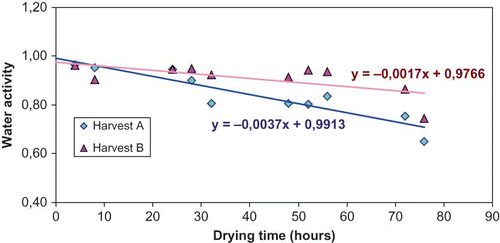
In , the values of pH are presented for the drying of pears from the two harvests mentioned before. With relation to this property, it is possible to see that it practically does not change along the drying cycle, and it was also not influenced by the harvest date.
FIGURE 2 Variation of pH during the drying cycle of pears in the solar stove, for two harvest dates (color figure available online).
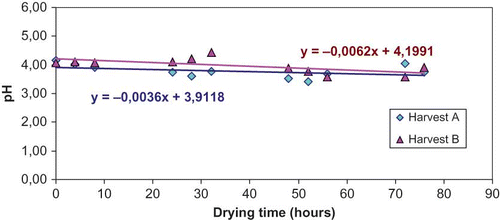
shows the variation of °Brix throughout the drying cycle, and in this case, it is possible to see that the pears increased significantly their soluble solids contents, thus, increasing the sugars contents during drying as the water evaporates. With respect to the different harvests, the increase was greater in harvest A, which is in agreement with the previous finding that the water activity decreased more in this case.
FIGURE 3 Variation of °Brix during the drying cycle of pears in the solar stove, for two harvest dates (color figure available online).
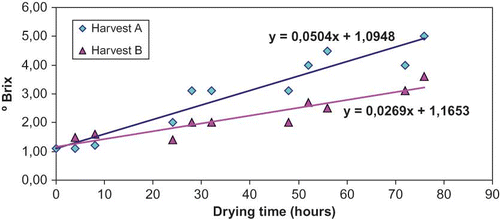
The graph in allows to conclude that the pear dimensions diminish quite substantially, thus, corresponding to a great degree of shrinkage. The diameter is most affected, reducing to about 50% of the initial value. The height reduces less, which is understandable considering that pears are dried uncut and, therefore, the height is less extensible because it contains the fibers of the central part that holds the seeds. The pulp around the pear is easily shrinkable, and that is the reason that explains the difference observed in the behavior of these two dimensions.
shows three graphs containing the values of moisture, °Brix, and acidity of pears dried by different methods: the traditional open sun exposure, the drying inside the solar stove with exposure through the glass, drying inside the solar drier and also in the drying tunnel. The results enable us to see that the pears were dried until approximately the same moisture content. However, the pears of the traditional system are sweeter, but also more acid, although these differences are not so intense.
FIGURE 5 Moisture content (a), °Brix (b), and acidity (c) of pears dried using different systems (color figure available online).
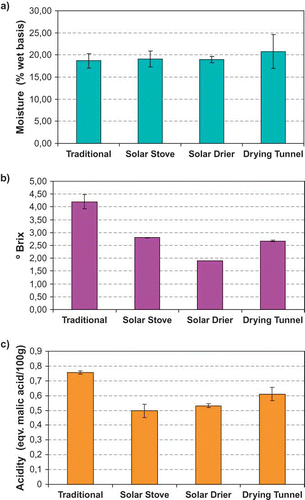
The graph in shows the variation of °Brix of pears in different years, for the drying systems seen before. It is possible to see that in the second year the pears were sweeter for all drying systems tested.
FIGURE 6 Variation of °Brix of pears in different years, for different drying systems (color figure available online).
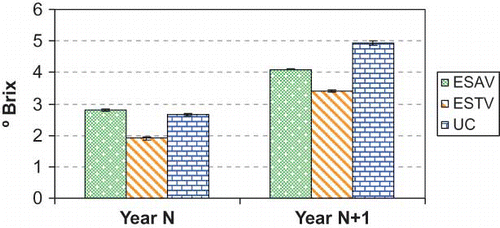
shows pears in different stages of drying using the traditional system, some that have been put to dry only a few hours before and others that have been drying for about 7 days, and, therefore, are at the end of the first drying phase. As it can be seen in the figure, the pears change their color during drying from a light beige color to a pronounced brownish-reddish color. This characteristic color is a very important quality attribute of this traditional food product; therefore, its development is of the utmost importance.
shows the variation of the color parameters of the pears with time for the drying cycle carried out in the solar stove. As it can be seen, the value of L* (lightness) decreases from 74 to 33, showing that the pears become much darker with drying. The value of a* increases from −4 to 23, revealing that a very slight green tone evolves to an intense red tone. The parameter b* practically does not change with drying, just varying from 18 at the beginning to 15 at the end, revealing that drying induces just a very slight diminish in the yellow intensity. The conjugation of the intense red with the darkness associated to the L* parameter gives place to a reddish-brown color in the dried pears.
FIGURE 8 Variation of color along the drying cycle for the solar stove (color figure available online).
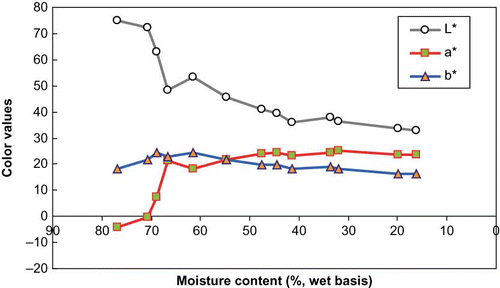
shows the values of the color parameters (L*, a*, b*) for pears dried under different drying conditions and with different systems: traditional solar drying, solar stove with pears at direct exposure to the sun and also covered not to receive the sun rays, electrical stove at 30 and at 40°C (in this system the pears are not exposed to the sun), and solar drier and drying tunnel with air heated by a solar collector (in this system the pears are also not exposed to the sun). The pears dried in the traditional system present a medium value for lightness of 26, which means that these pears are quite dark. As mentioned previously, the traditional pears function as the reference, since what is aimed is to produce pears with approximately the same color as these traditional ones.
From the results in , it can bee seen that the pears dried with direct sun exposure present values of lightness that are more similar to the traditional pears (L* = 33 and L* = 35, respectively). These two systems give pears that are more similar to the reference, and the values of L* for these two alternative systems are still higher than the traditional, indicating that the pears obtained in this way are slightly clearer than the reference. The other systems all give pears much clearer: L* = 44 for the UC drying tunnel, L* = 44 for the ESAV electrical stove at 30°C, L* = 46 for the ESAV solar stove covered, L* = 56 for the ESAV electrical stove at 40°C, this last one is particularly clear, and really much different from the intended lightness for the pears.
also shows the values of the color parameter a*, which is also very important for the evaluation of the color of the pears, since it refers to the reddish intensity of the color. The traditional pears show a value of a* around 20, and once again the two systems, which provide a direct exposure to the sun rays, are the ones that give pears with values of a* more similar to the reference: a* = 23 for both ESAV solar stove and ESTV solar drier. The other systems give pears with less intense red color, with values of a* equal to 15, 13, 11, and 7, respectively for ESAV solar stove covered, UC drying tunnel, ESAV electrical stove at 30°C and ESAV electrical stove at 40°C. Once again, the electrical stove operated at 40°C is the system that gives the product that least resembles the traditional pears.
In relation to the color parameter b* (), this parameter does not seem to present the same level of importance in the definition of the color of the pears as L* and a*, since the drying does not produce an important change in the value of b* from the fresh to the dried state. The traditional pears show a value of b* around 12, corresponding to a slight yellow intensity. With respect to this parameter, once more the two systems that provide the direct sun exposure are those that give the values of b* more close to the reference: b* = 16 for ESAV solar stove and b* = 17 for ESTV solar drier. The other systems give pears with a slight more intense yellow color, with values of b* equal to 18 for UC drying tunnel and also for ESAV electrical stove at 30°C, *b = 19 for ESAV solar stove covered, and b* = 20 for ESAV electrical stove at 40°C. Once more, the electrical stove at 40°C is the system that gives the product most different than the traditional pears.
shows the variation of the color parameters L*, a*, and b* in two consecutive years, for different drying systems: traditional drying, solar stove, solar drier, and drying tunnel. The results in reveal that for all drying systems the values of L* are higher in the second year (N + 1) when compared with the first year (N). Also the values of a* and b* show the same trend. This means that in year N + 1 the pears were lighter, redder, and more yellow, for all drying systems, including the pears dried by the traditional method. Furthermore, the observation that the two systems that originate dried pears more similar to the traditional ones are those which promote a direct exposure to the sun (solar stove and solar drier) is confirmed in two consecutive observation years.
CONCLUSIONS
The results obtained in different years of study reveal that the alternative drying systems tested (drying tunnel, solar stove, and solar drier) allow for obtaining end products that are very much alike. In particular, the two solar systems were very similar. Furthermore, the results obtained show that the three different drying methods do not produce fruits much different than those dried by the traditional method, with the advantages of guaranteeing the sanitary quality of the product and being more efficient in terms of productivity.
With respect to color, this work allowed us to conclude that it is possible to produce dried pears with a color similar to that of the traditional product using alternative drying methodologies. However, these alternative systems must still be based on a solar exposure (even though not direct), since it was found that those methodologies that do not provide a sun exposure will produce dried pears with different color characteristics than those from traditional drying. The dryings carried out in the solar drier and in the solar stove are particularly advisable in order to obtain the desired color.
In addition, since the fruits are protected inside the glass, they are not exposed to the potential contaminating agents and are also protected from adverse atmospheric conditions, thus, allowing drying to proceed even under less favorable atmospheric conditions, without product loss due to rain or night moisture. This conclusion is very important for the modernization of the production of this regional food product.
ACKNOWLEDGMENT
The authors would like to thank the FCT for financial support through project PTDC/AGR-ALI/74587/2006.
LITERATURE CITED
- Abdullah , M.Z. , Guan , L.C. , Lim , K.C. and Karim , A.A. 2001 . The applications of computer vision system and tomographic radar imaging for assessing physical properties of food . J. Food Eng. , 61 : 125 – 135 .
- AOAC . 1990 . Official methods of analysis , 16th , Washington, DC : Association of Official Analytical Chemists .
- Barroca , M.J. , Guiné , R.P.F. , Pinto , A. , Gonçalves , F.M. and Ferreira , D.M.S. 2006 . Chemical and microbiological characterization of Portuguese varieties of pears . Food and Bioproducts Proc. , 84 : 109 – 113 .
- Doymaz , I. 2007 . The kinetics of forced convective air-drying of pumpkin slices . J. Food Eng. , 79 : 243 – 248 .
- Guiné , R. , Lopes , P. , Barroca , M.J. and Ferreira , D.M.S. 2009 . Effect of ripening stage on the solar drying kinetics and properties of S. Bartolomeu Pears (Pyrus communis L.) . Intl. J. Acad. Res. , 1 : 46 – 52 .
- Guiné , R.P.F. , Ferreira , D.M.S. , Barroca , M.J. and Gonçalves , F.M. 2007 . Study of the drying kinetics of solar-dried pears . Biosys. Eng. , 98 : 422 – 429 .
- Guiné , R.P.F. and Castro , J.A.A.M. 2003 . Analysis of moisture content and density of pears during drying . Drying Technol. , 21 : 581 – 591 .
- Guine , R.P.F. and Castro , J.A.A.M. 2002 . Pear drying process analysis: Drying rates and evolution of water and sugar concentrations in space and time . Drying Technol. , 20 : 1515 – 1526 .
- Karathanos , V.T. and Belessiotis , V.G. 1997 . Sun and artificial air drying kinetics of some agricultural products . J. Food Eng. , 31 : 35 – 46 .
- Mendoza , F. , Dejmekb , P. and Aguilera , J.M. 2006 . Calibrated color measurements of agricultural foods using image analysis . Postharvest Biol.Technol. , 41 : 285 – 295 .
